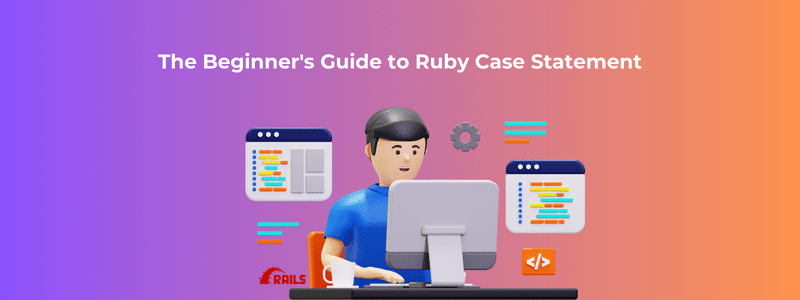Choosing the right technology stack for your product development is crucial for its success. Among the plethora of options available, Ruby on Rails (RoR) stands out as a popular choice for building web applications. In this blog post, we’ll delve into why Ruby on Rails might be the right choice for your product development.
¿Qué es Ruby on Rails?
Ruby on Rails, often simply referred to as Rails, is a popular open-source web application framework written in the Ruby programming language. It was created by David Heinemeier Hansson and released in 2004, and since then, it has gained significant traction in the web development community.
Rails follows the Model-View-Controller (MVC) architectural pattern, which separates the application into three interconnected components:
- Model: Represents the data and business logic of the application. It interacts with the database to perform CRUD (Create, Read, Update, Delete) operations.
- View: Handles the presentation layer of the application, generating the user interface based on the data provided by the controller.
- Controller: Acts as an intermediary between the model and the view, processing user requests, interacting with the model to retrieve or manipulate data, and rendering the appropriate view.
Key Features of Ruby on Rails:
- Convention over Configuration (CoC): Rails promotes sensible defaults and conventions, reducing the amount of boilerplate code and configuration required, which accelerates development.
- Don’t Repeat Yourself (DRY): Rails encourages developers to write reusable code, reducing redundancy and promoting code efficiency.
- ActiveRecord: Rails includes ActiveRecord, an Object-Relational Mapping (ORM) library that simplifies database interactions by abstracting the database into objects, making it easier to work with databases using Ruby.
- Integrated Testing Framework: Rails comes with built-in testing tools, including support for unit testing, integration testing, and system testing, facilitating the development of robust and maintainable applications.
- Gems: Rails leverages a vast ecosystem of libraries, known as gems, which provide additional functionality and features that can be easily integrated into Rails applications.
- Security: Rails provides built-in mechanisms to protect against common web vulnerabilities, such as SQL injection, cross-site scripting (XSS), and cross-site request forgery (CSRF).
1. Rapid Development
One of the standout features of Ruby on Rails is its focus on convention over configuration, which allows developers to write less code and build applications faster. With its elegant syntax and a vast collection of pre-built libraries, RoR enables developers to prototype and iterate on ideas quickly.
The “Don’t Repeat Yourself” (DRY) principle is another core tenet of Rails development. It emphasizes writing reusable code, reducing redundancy, and promoting efficiency. This approach accelerates the development process, making it ideal for startups and businesses looking to launch their products swiftly.
2. Mature Ecosystem
Ruby on Rails has been around for over a decade, resulting in a mature and robust ecosystem. This maturity translates into a wealth of resources, libraries, and tools available to developers, making it easier to address common web development challenges.
The community-driven nature of RoR means that developers can benefit from a vibrant community always willing to share knowledge, provide support, and contribute to the platform’s growth. This collaborative environment fosters innovation and ensures that the framework continues to evolve with industry trends.
3. Scalability
Contrary to some misconceptions, Ruby on Rails is fully capable of handling scalable applications. Airbnb, Shopify, and GitHub are just a few examples of successful companies that have built their platforms using RoR. With proper architectural planning and optimization, Rails applications can scale horizontally to meet growing demands.
Additionally, RoR’s modular design allows for seamless integration with other technologies, enabling developers to incorporate the best tools for specific tasks without compromising performance or scalability.
4. Security
Security is paramount in today’s digital landscape, and Ruby on Rails provides built-in features to help developers create secure applications. Some of these security features include protection against SQL injection, cross-site scripting (XSS), and cross-site request forgery (CSRF) attacks.
Moreover, the Rails community actively monitors and addresses security vulnerabilities, ensuring that the framework remains secure and up-to-date. By leveraging these built-in security measures and adhering to best practices, developers can build robust and secure applications with confidence.
5. Cost-Effective
Last but not least, Ruby on Rails can be a cost-effective choice for product development. Its open-source nature means that there are no licensing fees, reducing initial costs. Additionally, the framework’s efficiency and productivity-enhancing features can lead to lower development and maintenance costs over time.
Furthermore, the availability of skilled Desarrolladores RoR in the market can help businesses find talent without breaking the bank. This combination of affordability and productivity makes Ruby on Rails an attractive option for startups and enterprises alike.
What Are The Ruby Advantages And Disadvantages?
Ruby is a dynamic, reflective, object-oriented programming language known for its simplicity and productivity. While Ruby has gained popularity for web development, especially with the Ruby on Rails framework, like any programming language, it comes with its own set of advantages and disadvantages.
Advantages of Ruby:
- Simplicity and Readability: Ruby’s syntax is designed to be clear and readable, making it easier for developers to write and maintain code. Its English-like syntax reduces the learning curve, especially for beginners.
- Productivity: With its focus on developer happiness and efficiency, Ruby enables rapid development. Features like metaprogramming and dynamic typing allow developers to write less code to achieve more.
- Rich Ecosystem: Ruby has a vast ecosystem of libraries and frameworks, most notably Ruby on Rails, which facilitate the development of web applications, APIs, and more. These libraries, or “gems,” provide solutions for a wide range of tasks, saving developers time and effort.
- Community and Support: Ruby has a strong and supportive community that actively contributes to its growth. The community-driven nature of Ruby ensures a wealth of resources, tutorials, and forums available for assistance.
- Flexibility: Ruby’s dynamic nature allows for flexible and expressive code, making it suitable for various programming paradigms, including procedural, functional, and object-oriented programming.
Disadvantages of Ruby:
- Performance: Compared to some other programming languages like C or Java, Ruby can be slower due to its interpreted nature and dynamic typing. While performance improvements have been made over the years, performance can still be a concern for CPU-intensive tasks.
- Memory Consumption: Ruby applications can consume more memory compared to applications written in languages like C or Go. This can be a limitation, especially for applications requiring high concurrency and scalability.
- Dependency Management: Managing dependencies, especially with gems and their versions, can sometimes lead to dependency conflicts or compatibility issues, which can complicate the development process.
- Learning Curve for Metaprogramming: While metaprogramming in Ruby can be powerful, it can also be challenging to understand and debug, especially for beginners. Overuse of metaprogramming can lead to code that is hard to maintain and understand.
- Less Common in Enterprise: While Ruby is popular in web development and startups, it is less commonly used in large enterprise environments compared to languages like Java or C#. This can sometimes limit job opportunities or support in enterprise settings.
Why Choose Ruby on Rails?
- Rapid Development: Rails’ focus on convention over configuration and DRY principles enables developers to build web applications quickly.
- Mature Ecosystem: Rails has a robust and mature ecosystem with a vibrant community, offering a wealth of resources, libraries, and tools.
- Scalability: Despite some misconceptions, Rails is capable of handling scalable applications when properly optimized and architected.
- Security: Rails includes built-in security features and is actively maintained to address security vulnerabilities.
- Cost-Effective: Being open-source, Rails eliminates licensing fees, and its efficiency can lead to reduced development and maintenance costs.
Conclusión
Ruby on Rails offers a compelling blend of rapid development, a mature ecosystem, scalability, security, and cost-effectiveness, making it a viable choice for a wide range of product development projects. Whether you’re a startup looking to launch your MVP or an established business aiming to modernize your web applications, RoR provides the tools and support needed to bring your ideas to life. If you’re considering Ruby on Rails for your next project, we hope this blog post has provided valuable insights into the benefits of choosing this popular web development framework. To know more connect with RielesCarma.





